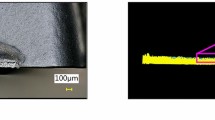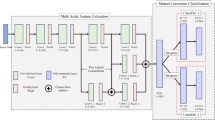Abstract
This paper introduces the usage of semi-supervised learning to obtain competitive detection accuracy of measuring drilled holes on composite parts with very limited noisy training data. An improved texture segmentation algorithm based on local binary patterns algorithm is proposed, named local exponential patterns. The algorithm divides the image texture into nine levels, of which the highest level of texture is selected for contour extraction. An ellipse fitting method is used to fit the target contours and vote for the candidate ellipses. The regions inside the candidate ellipses are taken as the semi-supervised semantic label for images. A new loss named round loss is proposed, and a superior circle segmentation model was trained by learning from incompletely annotated data. To verify the effectiveness of the method, experiments were conducted with the drilled holes on the composite parts. The results show that the proposed semi-supervised deep learning approach is exceedingly suitable for circle detection of holes with different texture information commonly found in robotic drilling. Massive data labeling can be completely avoided with proposed method. The measurement accuracy can reach 0.03 mm, which can meet the visual measurement requirements of the circular holes on composite parts in the robotic drilling system.











Similar content being viewed by others
References
Pham, S.: Digital circles with non-lattice point centers. Vis. Comput. 9(1), 1–24 (1992). https://doi.org/10.1007/BF01901025
Hu, P., Peng, D., Guo, J., Zhen, L.: Local feature based multi-view discriminant analysis. Knowl.-Based Syst. 149, 34–46 (2018). https://doi.org/10.1016/j.knosys.2018.02.008
Hu, P., Peng, D., Sang, Y., Xiang, Y.: Multi-view linear discriminant analysis network. IEEE Trans. Image Process. (2019). https://doi.org/10.1109/tip.2019.2913511
Martínez, J., García, A.S., Molina, J.P., Martínez, D., González, P.: Erratum to: an empirical evaluation of different haptic feedback for shape and texture recognition. Vis. Comput. 29(5), 467 (2013). https://doi.org/10.1007/s00371-013-0781-9
Lingkun, L., Wang, X., Hu, S., Hu, X., Zhang, H., Liu, Y., Zhang, J.: A unified framework for interactive image segmentation via Fisher rules. Vis. Comput. (2018). https://doi.org/10.1007/s00371-018-1580-0
Peng, X., Feng, J., Xiao, S., Yau, W., Zhou, J.T., Yang, S.: Structured autoencoders for subspace clustering. IEEE Trans. Image Process. 27(10), 5076–5086 (2018). https://doi.org/10.1109/TIP.2018.2848470
Amirolad, A., Arashloo, S.R., Amirani, M.C.: Multi-layer local energy patterns for texture representation and classification. Vis. Comput. 32(12), 1633–1644 (2016). https://doi.org/10.1007/s00371-016-1220-5
Duda, R.O., Hart, P.E.: Use of the Hough transform to detect lines and curves in pictures. Commun. ACM-CACM 15(1), 11 (1975)
Nakanishi, M., Ogura, T.: Real-time CAM-based Hough transform algorithm and its performance evaluation. Mach. Vis. Appl. 12(2), 59–68 (2000). https://doi.org/10.1007/s001380050125
Shaked, D., Yaron, O., Kiryati, N.: Deriving stopping rules for the probabilistic Hough transform by sequential analysis. Comput. Vis. Image Underst. 63(3), 512–526 (1996). https://doi.org/10.1006/cviu.1996.0038
Xu, L., Oja, E., Kultanen, P.: A new curve detection method: randomized hough transform (RHT). Pattern Recognit. Lett. 11(5), 331–338 (1990). https://doi.org/10.1016/0167-8655(90)90042-Z
Han, J.H., Kóczy, L.T., Poston, T.: Fuzzy Hough transform. Pattern Recognit. Lett. 15(7), 649–658 (1994). https://doi.org/10.1016/0167-8655(94)90068-x
Chen, T.-C., Chung, K.-L.: An efficient randomized algorithm for detecting circles. Comput. Vis. Image Underst. 83(2), 172–191 (2001). https://doi.org/10.1006/cviu.2001.0923
Chung, K.-L., Huang, Y.-H.: Speed up the computation of randomized algorithms for detecting lines, circles, and ellipses using novel tuning-and LUT-based voting platform. Appl. Math. Comput. 190(1), 132–149 (2007). https://doi.org/10.1016/j.amc.2007.01.012
Chung, K.-L., Huang, Y.-H., Shen, S.-M., Krylov, A.S., Yurin, D.V., Semeikina, E.V.: Efficient sampling strategy and refinement strategy for randomized circle detection. Pattern Recognit. 45(1), 252–263 (2012). https://doi.org/10.1016/j.patcog.2011.07.004
Ayala-Ramirez, V., Garcia-Capulin, C.H., Perez-Garcia, A., Sanchez-Yanez, R.E.: Circle detection on images using genetic algorithms. Pattern Recognit. Lett. 27(6), 652–657 (2006). https://doi.org/10.1016/j.patrec.2005.10.003
Cuevas, E., Oliva, D., Zaldivar, D., Pérez-Cisneros, M., Sossa, H.: Circle detection using electro-magnetism optimization. Inf. Sci. 182(1), 40–55 (2012). https://doi.org/10.1016/j.ins.2010.12.024
Akinlar, C., Topal, C.: EDCircles: a real-time circle detector with a false detection control. Pattern Recognit. 46(3), 725–740 (2013). https://doi.org/10.1016/j.patcog.2012.09.020
Chen, S., Xia, R., Zhao, J., Chen, Y., Hu, M.: A hybrid method for ellipse detection in industrial images. Pattern Recognit. 68, 82–98 (2017). https://doi.org/10.1016/j.patcog.2017.03.007
Smith, J.R., Shih-Fu, C.: Automated binary texture feature sets for image retrieval. In: 1996 IEEE International Conference on Acoustics, Speech, and Signal Processing Conference Proceedings, 9–9 May 1996, vol. 2234, pp. 2239–2242
Haralick, R., Shanmugam, K., Dinstein, I.H.: Texture features for image classification. IEEE Trans. Syst. Man Cybern. 3, 610–621 (1973)
Mallat, S.G.: A theory for multiresolution signal decomposition: the wavelet representation. IEEE Trans. Pattern Anal. Mach. Intell. 11(7), 674–693 (1989). https://doi.org/10.1109/34.192463
Galloway, M.M.: Texture analysis using gray level run lengths. Comput. Gr. Image Process. 4(2), 172–179 (1975). https://doi.org/10.1016/S0146-664X(75)80008-6
Hassner, M., Sklansky, J.: The use of Markov random fields as models of texture. Comput. Gr. Image Process. 12(4), 357–370 (1980). https://doi.org/10.1016/0146-664X(80)90019-2
Ojala, T., Pietikäinen, M., Harwood, D.: A comparative study of texture measures with classification based on featured distributions. Pattern Recogn. 29(1), 51–59 (1996). https://doi.org/10.1016/0031-3203(95)00067-4
Pietikäinen, M., Ojala, T., Xu, Z.: Rotation-invariant texture classification using feature distributions. Pattern Recognit. 33(1), 43–52 (2000). https://doi.org/10.1016/S0031-3203(99)00032-1
Ojala, T., Pietikäinen, M., Mäenpää, T.: A generalized local binary pattern operator for multiresolution gray scale and rotation invariant texture classification. In: Singh, S., Murshed, N., Kropatsch, W. (eds.) Advances in pattern recognition—ICAPR 2001, pp. 399–408. Springer, Berlin (2001)
Gou, J., Wang, L., Hou, B., Lv, J., Yuan, Y., Mao, Q.: Two-phase probabilistic collaborative representation-based classification. Expert Syst. Appl. 133, 9–20 (2019). https://doi.org/10.1016/j.eswa.2019.05.009
Long, J., Shelhamer, E., Darrell, T.: Fully convolutional networks for semantic segmentation. Arxiv 79 (2014)
Ronneberger, O., Fischer, P., Brox, T.: U-Net: convolutional networks for biomedical image segmentation. In: Navab, N., Hornegger, J., Wells, W.M., Frangi, A.F. (eds.) Medical image Computing and Computer-Assisted Intervention–MICCAI 2015, pp. 234–241. Springer International Publishing, Cham (2015)
Sánchez López, L.: Local Binary Patterns applied to Face Detection and Recognition. Universitat Politècnica De Catalunya, Spain (2010)
Canny, J.: A computational approach to edge detection. IEEE Trans. Pattern Anal. Mach. Intell. PAMI-8(6), 679–698 (1986). https://doi.org/10.1109/tpami.1986.4767851
Mei, B., Zhu, W., Yan, G., Ke, Y.: A new elliptic contour extraction method for reference hole detection in robotic drilling. Pattern Anal. Appl. 18(3), 695–712 (2015). https://doi.org/10.1007/s10044-014-0394-6
Badrinarayanan, V., Kendall, A., Cipolla, R.: SegNet: a deep convolutional encoder-decoder architecture for image segmentation. IEEE Trans. Pattern Anal. Mach. Intell. 39(12), 2481–2495 (2017). https://doi.org/10.1109/TPAMI.2016.2644615
Everingham, M., Eslami, S.M.A., Van Gool, L., Williams, C.K.I., Winn, J., Zisserman, A.: The pascal visual object classes challenge: a retrospective. Int. J. Comput. Vis. 111(1), 98–136 (2015). https://doi.org/10.1007/s11263-014-0733-5
Maletic, J.I., Marcus, A., Grzymala-Busse, J.W., Grzymala-Busse, W.J., Burges, C.J.C., Chizi, B., Maimon, O., Ying, Y., Webb, G.I., Wu, X.: Data mining and knowledge discovery handbook. Kybernetes 33(7), 809–835 (2005)
Otsu, N.: A threshold selection method from gray-level histograms. IEEE Trans. Syst. Man Cybernet. 9(1), 62–66 (1979). https://doi.org/10.1109/TSMC.1979.4310076
Bieniek, A., Moga, A.: An efficient watershed algorithm based on connected components. Pattern Recognit. 33(6), 907–916 (2000). https://doi.org/10.1016/S0031-3203(99)00154-5
Achantay, R., Hemamiz, S., Estraday, F., Süsstrunky, S.: Frequency-tuned salient region detection. In: 2009 IEEE Computer Society Conference on Computer Vision and Pattern Recognition Workshops, CVPR Workshops 2009, pp. 1597–1604 (2009). https://doi.org/10.1109/cvprw.2009.5206596
Acknowledgements
This research is supported by National Natural Science Foundation of China (No.51675479, 51205352, 51575479, 51521064) and Special scientific research for civil aircraft (NO.MJZ-G-2011-07).
Author information
Authors and Affiliations
Corresponding author
Additional information
Publisher's Note
Springer Nature remains neutral with regard to jurisdictional claims in published maps and institutional affiliations.
Rights and permissions
About this article
Cite this article
Li, G., Yang, S., Cao, S. et al. A semi-supervised deep learning approach for circular hole detection on composite parts. Vis Comput 37, 433–445 (2021). https://doi.org/10.1007/s00371-020-01812-w
Published:
Issue Date:
DOI: https://doi.org/10.1007/s00371-020-01812-w




